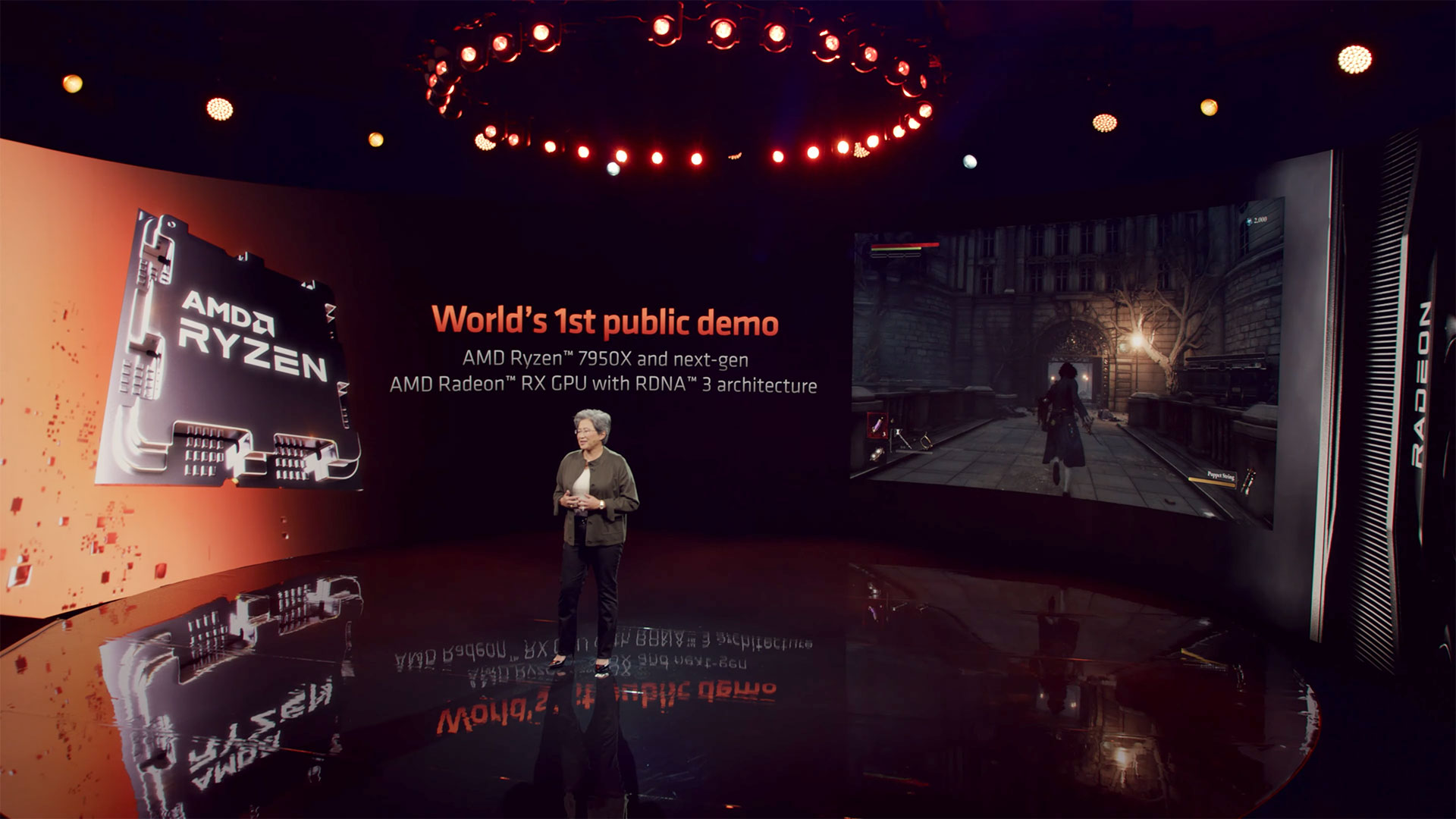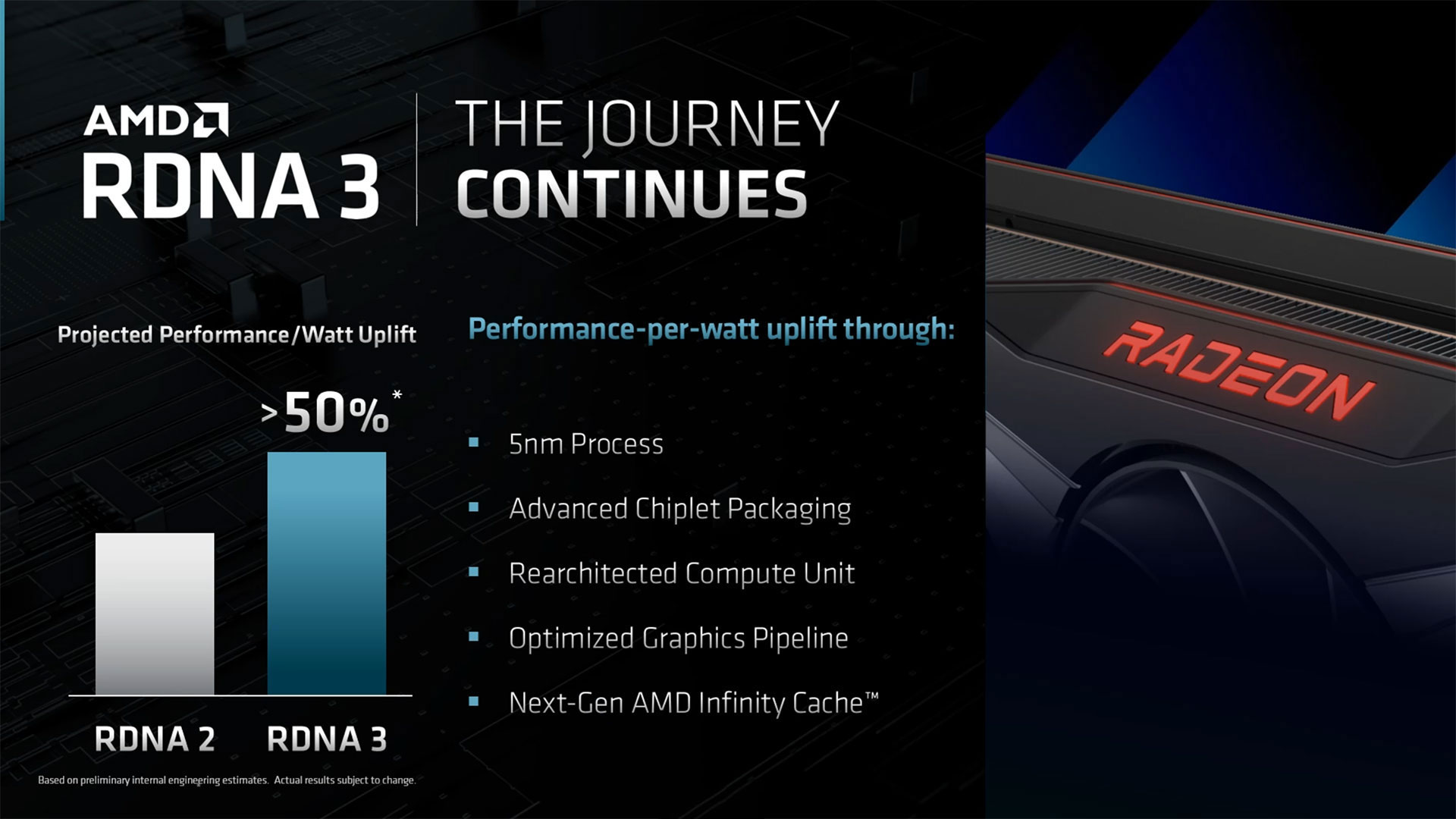AMD Demonstrates Working 5nm RDNA 3 Chiplet GPU
Still coming in 2022, probably November or December
AMD's Radeon RX 7000-series is coming, and working hardware is now in AMD's labs. At its Ryzen 7000 launch event, AMD demonstrated a working RDNA 3 GPU, aka Navi 3x, aka RX 7000, running a pre-release build of Lies of P. (Jump to 30:48 in the above video if the embed doesn't do that automatically.) That of course tells us precisely nothing about the GPU performance or hardware other than the fact that it exists, since no one else has the game and thus can't benchmark it or say how it runs on competing GPUs. Still, RDNA 3 is in the house!
It's shaping up to be an exciting fall for those looking to upgrade to one of the best graphics cards, as we should be getting new Nvidia Ada RTX 40-series GPUs alongside AMD's RDNA 3 offerings. Who will come out on top is anybody's guess right now, though it's a safe bet that Nvidia's new graphics cards will launch first.
We say that because the latest rumors and performance leaks suggest RTX 40-series cards are getting close to shipping, and people who likely work for major add-in card partners appear to have the hardware as well. AMD's RDNA 3 meanwhile has only been demonstrated on AMD's stage in a very limited fashion — the "one more thing" that AMD CEO Lisa Su likes to toss in at the end of presentations.
History tells us that when AMD shows off an upcoming GPU as "one more thing," it's typically anywhere from three to six months out. However, Su did say that RDNA 3 would be coming "later this year," which means it has less than four months to get the products out the door.

AMD's demo was running at 4K and ultra settings, and it seemed to be smooth, but again that doesn't tell us much. Su goes on to say that it expects to deliver more than a 50% improvement in performance per watt compared to the current RDNA 2 (Radeon RX 6000-series) GPUs, but that also tells us very little. RDNA 2 if you'll recall was also supposedly 50% better in performance per watt than RDNA GPUs.
According to our GPU benchmarks hierarchy, the RX 6900 XT consumes 308W of power while delivering 130 fps at 1080p ultra, 106 fps at 1440p ultra, and 63 fps at 4K ultra. A lower tier RX 6700 XT uses 215W and averages 96 fps, 71 fps, and 39 fps, while the RX 5700 XT consumes 214W while delivering 74 fps, 53 fps, and 29 fps at those same resolutions. Do the math and the 6900 XT provides a 22% to 50% improvement in performance per watt, while the 6700 XT only provides a 29% to 34% improvement.
The devil as always is in the details, and we'll have to wait for RDNA 3 hardware to launch before we can determine exactly how good it is compared to its predecessor. Most likely, it will end up being "up to more than 50% better performance per watt," but only for select comparisons — like at 4K ultra perhaps, or maybe just when cherry picking which GPUs you want to compare.

As with Nvidia's RTX 40-series, we expect AMD to launch with higher performance and higher priced variants first. However, RDNA 3 will also be using 5nm GPU chiplets. That means it's possible the top-performing solutions from AMD will be composed of multiple chiplets, and it could thus launch a midrange offering simultaneously. On the other hand, we're still trying to determine what exactly AMD intends to do with "GPU chiplets."
With its Ryzen CPUs, AMD has a central IO chiplet that connects to memory, PCIe, and other interfaces. This is fabricated on a previous generation 12nm process in the case of the Ryzen 5000-series, and that's fine because external interfaces generally don't scale well with smaller nodes. The CPU chiplets are then manufactured on a 7nm, and soon to be 5nm, process node, connected to the IO chiplet via AMD's Infinity Fabric. Could AMD do something similar with GPUs? Perhaps, or it could go an entirely different direction.
One of the rumors floating around is that AMD will be using memory interface chiplets. The idea is to move all the GDDR6 controllers on to chiplets... which would then link to the main GPU via Infinity Fabric. We're not entirely sure what the benefit would be, since you'd still need Infinity Fabric on each of the chiplets, but we'll find out what exactly AMD plans in the coming months.
Lisa Su says the unnamed RDNA 3 GPU — presumably the top-tier model, but we don't know for certain — was running Lies of P at 4K and ultra settings. She also states that, "We are feeling great about how RDNA 3 looks in the labs, and I can't wait to tell you more about it when we launch later this year." We're excited as well, though it appears we'll have no choice but to wait a bit longer.
Get Tom's Hardware's best news and in-depth reviews, straight to your inbox.

Jarred Walton is a senior editor at Tom's Hardware focusing on everything GPU. He has been working as a tech journalist since 2004, writing for AnandTech, Maximum PC, and PC Gamer. From the first S3 Virge '3D decelerators' to today's GPUs, Jarred keeps up with all the latest graphics trends and is the one to ask about game performance.
-
jp7189 When hearing about GPU chiplets i expected AMD to do something similar to their CPUs. A central I/O and cache die plus 1,2, or 4 GPU dies (depending on tier). However, there was a leak article here about a month ago that painted the opposite picture of a central GCD (the GPU) surrounded by smaller MCDs (memory chiplets). They had die area measurements and other specific details that made it sound awfully authentic.Reply
